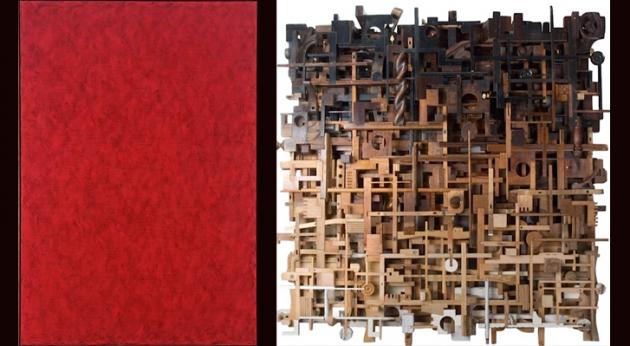The Knight Webb Gallery will be presenting ‘In a Silent Way’, an exhibition of monochrome paintings by Anders Knutsson and recycled wood sculptures by Lesley Hilling. Taking its name from the seminal Miles Davis album, this exhibition is a dialogue between two artists with separate influences, working on opposite sides of the Atlantic.The jazz metaphor illustrates the intangible elements in both artists work, be it Anders deep Zen minimalism or Lesley’s meandering nostalgic constructions of found wood and objects that weave a labyrinth of memory. In a Silent Way invites you to get to know these well known artists better, in the intimate space of Knight Webb Gallery.
Jazz is the precursor of Revolution, Miles had said, Revolution follows it around. Our two artists grew out of cultural revolution. Knutsson, in the studios he shared with Brice Marden in 1960s Manhattan, was in the heart of the second round of modernism. For nearly 50 years the artist has searched for the purest essence of colour.
In a countercultural Brixton, Lesley Hilling has been living and working since 1983, her sculptures growing organically from discarded pianos and unwanted furniture. Her work takes the classical and the antiquated, then breaks it down to smaller building blocks, which rise up into modernist composite towers, like housing projects rising out of the slums.
The works in this exhibition respond to music. Knutsson’s layers of translucent paint sing the blues in clear electric colours, inducing a second plane of consciousness. The way in which Hilling’s intricate wooden sculptures have been pieced together invoke a staccato rhythm, a crescendo and diminuendo, a pause, a repetition. The way they grow organically without forethought has parallels in the improvisation of the jazz world.The marriage of Knutsson and Hilling’s work has for us the spiritual and physical attributes of music, but more significantly the jazz scene that formed the cultural backdrop of their production.
Lesley Hilling: Hilling has spent a lifetime experimenting with recycled wood, often from discarded pianos. She builds towers, which grow organically out of wooden fragments. Her studio is a cabinet of curiosities of junk furniture and other ephemera. Found photographs, camera parts, and books are all objects that are integrated into her striking, constructions. There is a strong sense of the past, something contemporary yet antiquated between the varnished piano wood and the old camera lenses.
Anders Knutsson: Anders Knutsson is a Swedish, American painter and a distinguished member of 1960s avant-garde movement in New York. He is involved in every stage of his work, from making his own paint to commissioning traditional weavers to fabricate his linen canvases. His paintings, made of almost transparent layers of colour, unveil subtle depths. Knutsson’s aesthetics subscribe to the historical influence of East Coast Minimalist painting, which ran simultaneously to its counterparts in music and sculpture during the late 1960s and 1970s.
What connects these two artists, apart from a shared space? This exhibition makes the connection between shared cultures in New York and London, and a love of jazz music. There is a deep and specific concern for materials in the work of both artists.Anders paintings are as sculptural as Lesley Hilling’s sculptures are painterly. Both artists have arrived at moments of maturity in their work. Having spent decades refining their practice, both Knutsson and Hilling are producing work at a highly attuned level. On the other hand these artists still tell very different stories: Hilling’s wooden sculptures are woven with memories and associations. Knutsson’s oeuvre is a search for the spiritual.Together the works talk to each other of two different intangibilities. With their quiet internal energy, the colourfield paintings support the antiquity of Hilling’s sculpture and invite a moment of reflection, in a silent way.

